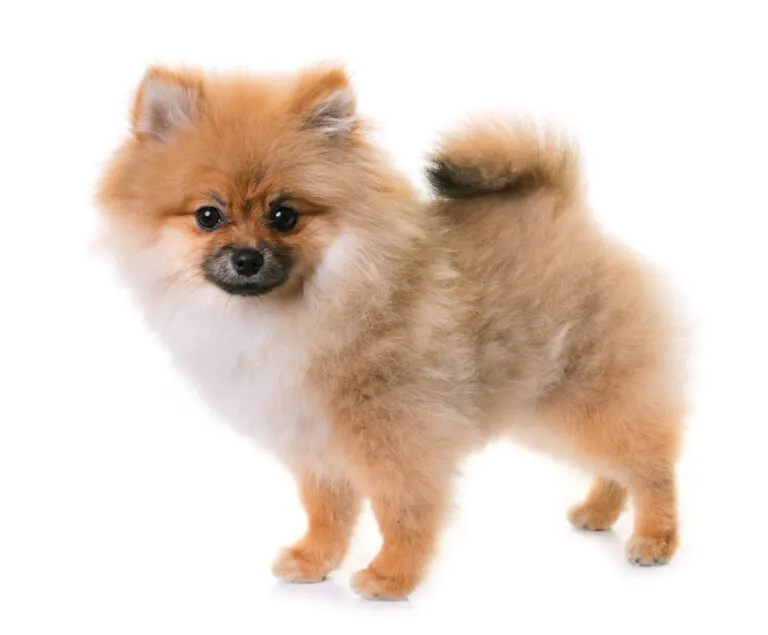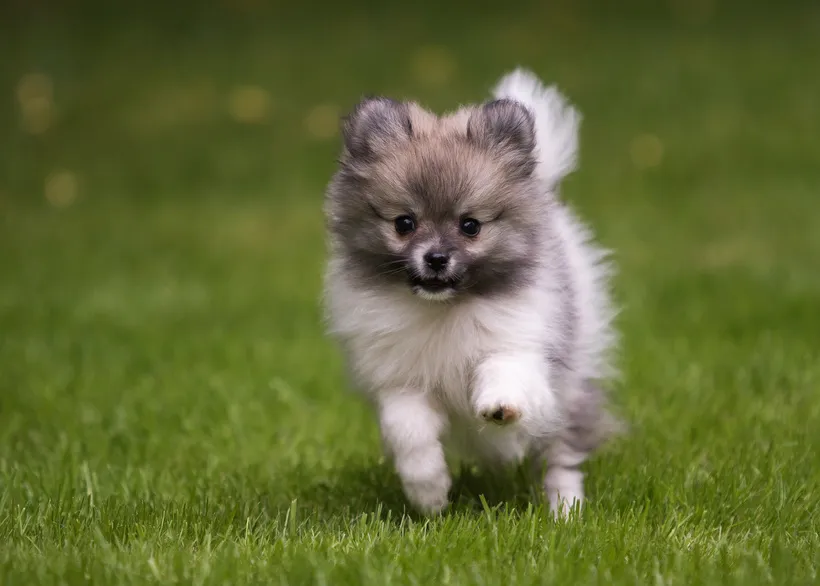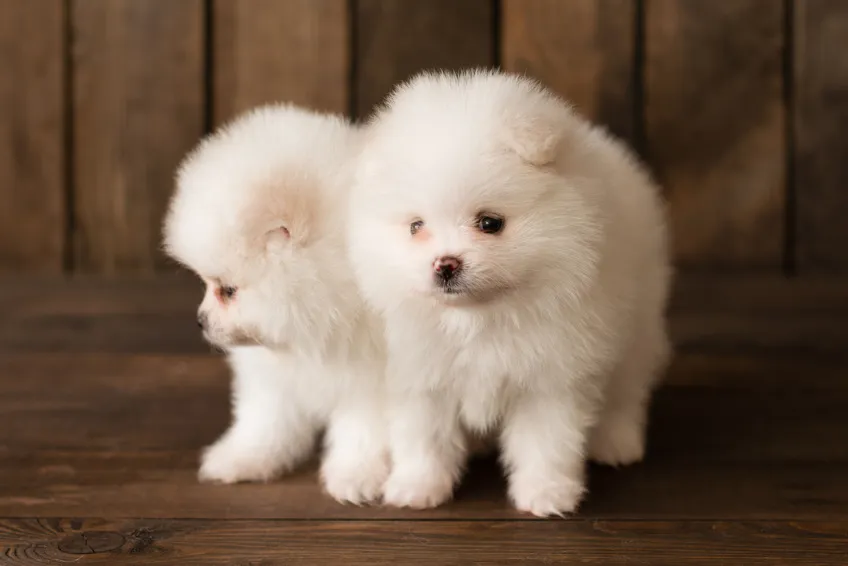Beagle
The Beagle's short legs can be deceiving – this medium-sized dog keeps you on your toes and is always full of surprises! This friendly breed is active, fearless and extremely clever.
Pomeranians are a confident breed with a friendly demeanor towards other dogs and humans. It is no surprise that more and more of these energetic Spitz dogs are conquering the hearts of dog lovers.

© cynoclub / stock.adobe.com
Pomeranians are confident and energetic dogs.
With a shoulder height of 18 to 22cm, it weighs a maximum of 3.5kg, making it lighter than most cats. Pomeranians have thick fur with a thick undercoat. There are plenty of colour variants such as white, sand, black, cream or a mixed. Their collar resembling a lion’s mane frames an attentive face with alert eyes and a fox-like snout. The fluffy coat makes these tiny dogs appear larger than they are.
Strictly speaking, the Pomeranian isn’t a stand-alone breed and is actually a mini version of the German Spitz. Whilst the Spitz itself is a very old breed, breeding of the Pomeranian has only become more established in the last few decades. Their name stems from their German origin province of Pommern. Whilst these Mini Spitzes were bred in the UK for a long time, breeding in Germany only intensified from the 1970s. However, breeding of these cute fur-balls also attracted criticism, since smaller Spitzes are more prone to certain diseases than their robust relatives. Pomeranians are still mainly popular in the US and Britain.
 © bina01 / stock.adobe.com
© bina01 / stock.adobe.com
The Pomeranian is small, although it is completely unaware of tis. Their great self-confidence and at times arrogance – often towards much bigger dogs too is more funny than aggressive. Ultimately, they are vigilant but friendly towards humans and animals. They are well-suited to being kept with several other pets, although they always have a close bond with their caregiver and are happiest being able to accompany them everywhere they go. They mostly radiate positivity and are always keen to play. As good watchdogs, they bark surprisingly loud for their size if strangers approach their territory. They can also bark when they’re happy or as a greeting – hence, neither their owners nor their neighbours should be too sensitive to noise. In contrast, they show barely any hunting instinct at all.
Make sure you train your Pomeranian to stay alone for a few hours as early as possible. This gets more and more difficult the older dogs get. Although you shouldn’t leave them alone longer than necessary. Staying alone is difficult for this breed by nature. Get it used to other pets and dogs in the first few weeks of its life – ideally attend nearby puppy play sessions offered by dog schools together. At an early stage, you should be able to counteract an overly confident demeanor towards other dogs through extensive socialisation and plenty of controlled contact with other canines. In principle, the Pomeranian enjoys learning and is quick to do so.
Also read our articles on dog training!
Despite its small size, the Pomeranian is no couch potato and very much enjoys long hikes at a moderate pace, though is satisfied with short walks around the block in bad weather. A big advantage can be that this breed is straightforward to carry, for instance, up stairs or on trains. Your Pomeranian loves learning new tricks and winning praise from you. Clicker training is great fun for most human-Spitz duos. Ball games or agility adapted to its size can also bring great joy to this breed – simply try out what you both like and always feel free to try new things. These cheerful dogs can even be deployed as therapy dogs with appropriate training.
 © chernikovatv / stock.adobe.com
© chernikovatv / stock.adobe.com
Make sure that this delicate dog does not gain excess weight as it can affect its health profoundly. Pomeranian food should be fed in small amounts and be of high quality. Regardless of whether you choose wet or dry food, make sure that your dog’s food contains a high proportion of meat. However, you’re best off steering clear of food containing grain. Of course you can also alternate between wet and dry food so that your dog benefits from the advantages of each. Wet food often tastes better to these little bundles of energy and also contains plenty of moisture and less calories. When it comes to dry food, you should definitely make sure that your dog gets enough to drink. Choose a dry food for small breeds, because the size of the biscuits is ideally tailored to your companion’s small jaw. The manufacturer’s guideline to daily portions can give an initial indication, but calorie requirements depend significantly on your canine companion’s constitution. Always give your Pomeranian time to rest after meals or for a nap to aid digestion. It’s sufficient to feed adult dogs once to twice a day. Be sparing with treats and bear in mind that an increase of 500g on the scales can be an increase of over 10% of the overall body weight for such a small dog.
Unfortunately extremes lead to a greater disposition towards diseases and the Pomeranian is no exception. It tends to have misaligned kneecaps, respiratory problems due to a tracheal collapse and cardiac diseases. As a result, it’s important to only buy puppies from breeders who value healthcare provision. Weighing just 3kg, these feather-light dogs don’t need much food. Ultimately, obesity must absolutely be avoided. These little fur-balls are sensitive to heat and need plenty of shade during sunny days. Moreover, avoid longer walks during the day and wait until the weather is cooler. Despite these restrictions, Pomeranians can reach 12 to 16 years of age.
The abundant coat of these little Spitzes needs regular brushing. You’re best off planning twice-weekly grooming sessions during which you thoroughly brush their abundant fur, against the grain too. Special cleansers from pet stores are suitable for the eyes and ears. Some dog owners regularly clean their dog’s teeth with a special dog toothpaste and toothbrush. If you get your dog used to this when it is still a puppy, it is an effective way of preventing tartar. Alternatively or additionally, dental care snacks or dried chews for small dogs are recommended.
These affectionate dogs love to be involved as much as possible. This means that they do not like to stay alone for long. Although they are very lively, they enjoy letting off steam playing games without the need for long walks. Therefore, they are well-suited both to less active as well as active people. Families with small children should always ensure that these little dogs have opportunities to retreat. Their small size often leaves them no other option than to bite if driven into a corner. They are better suited to families with older children who show consideration to the Pomeranian’s size and enjoy training it. First-time dog owners can also get on well with a Pomeranian if they don’t underestimate the time commitment required for play and grooming. These cheerful mini dogs can be kept in cities with no problems, since they quickly adapt to all environments. The most important factor being that their caregiver spending plenty of time with them.
The Pomeranian is an ideal travel companion. Due to its affectionate character, you shouldn’t hand it over to a stranger when you go on holiday. It is easy to transport everywhere with its size and can be taken with you in a carrier or even in the cabin.
Before purchasing a Pomeranian, bear in mind that you are going to be responsible for it for the coming years once it enters your home and that activity and grooming will take up some of your time on a daily basis. Along with the purchase price for a puppy, there are also the costs of basic equipment (bowls, collar, harness, lead, toys, blanket, basket, grooming accessories and a carrier for the car) and ongoing costs for dog tax and liability insurance, as well as routine check-ups at the vet. If your dog falls ill, these costs can skyrocket unexpectedly.
If you’ve fallen for this breed, you should only look for a puppy from breeders belonging to an association. Firstly, the Pomeranian Spitz in particular can have a genetic disposition towards some diseases. Secondly, these breeders are likely to be more ethical. In conclusion, knowledgeable breeders give the best healthcare provision. Mental stability is also a breeding goal for responsible breeders. A trustworthy breeder will always allow you to visit the puppies prior to adoption. They will also be happy to answer your queries regarding your Pomeranian dog. Make sure that the parent animals come across as healthy and even-tempered. Generally, your new housemate will move in with you at the age of eight weeks at the earliest. Along with a pedigree certificate, your microchipped and dewormed dog will also have a vaccination card.
If an older Pomeranian is an alternative for you, you can get searching online, where there are some of these kind-hearted canines waiting for a new home. Along with breeding associations, organisations dedicated to rehoming Spitzes can often help out.
The Beagle's short legs can be deceiving – this medium-sized dog keeps you on your toes and is always full of surprises! This friendly breed is active, fearless and extremely clever.
The Golden Retriever is still one of the most popular dog breeds, especially with families. It is defined not just by its docility, but shows numerous other qualities too. Read in the following article everything you need to know about the Golden Retriever.
The German Shepherd is one of the most popular utility dog breeds in the world, though the willing-to-learn and people-focused nature of these versatile dogs also makes them suitable for family life.